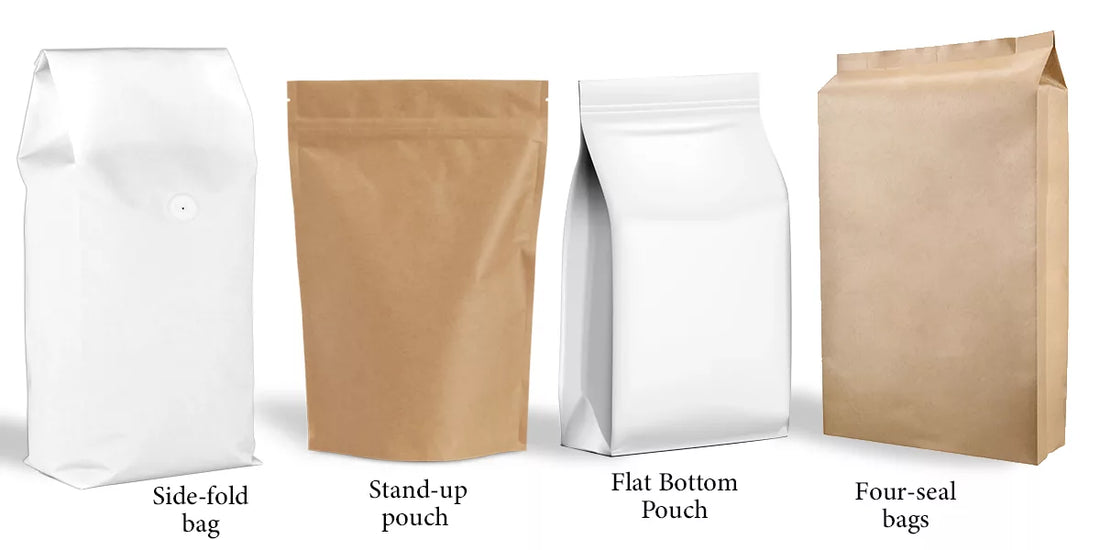There are many types of coffee bean bags, depending on the shape, outer material, and the names and sizes are also very different. The following is detailed information about coffee packaging.
Types of Common Coffee Bags
There are several types of coffee bags available in the market, each with its own unique design and purpose. Here are some of the most common types:
- Stand Up Pouches No Valve, No Window, With Zip Lock | Custom Logo | Wholesale Price
- Stand Up Pouches with Window | Wholesale Canada | Full Sizes
- Coffee Bags With Valve & Zipper, No Window | Fullsize | Wholesale
- Collection of popular coffee bags of all sizes

Stand Up Pouch
A stand-up pouch, as the name suggests, is designed to stand upright on its own. It has a flat bottom that allows it to stay stable on store shelves or kitchen counters. The bag is typically made of a combination of plastic and aluminum foil layers to provide optimum protection against moisture, light, and air.
How Much Will A Stand Up Pouch Hold?
Flat Bottom Bags
Flat bottom bags, also known as box pouches, have a square or rectangular bottom that provides extra space for coffee beans. This design helps to keep the bag standing tall and prevents it from tipping over. Flat bottom bags are popular for their ability to retain the freshness and aroma of coffee beans for a longer period.
- Flat Bottom Bags No Valve | 8, 16, 32 Oz | No Window, With Pocket Zipper | Wholesale
-
Flat-Bottom Bag With Valve | 8, 16, 32 Oz | For Coffee Beans, Coffee Roast
Gusseted Bags
Gusseted bags are widely used for packaging various products, including coffee. They have a unique construction with expandable sides, allowing the bag to expand when filled with coffee beans. This design maximizes the storage capacity of the bag while providing a sleek and professional appearance.
-
Bottom gusset bag: A bottom gusset bag has expandable sides and a flat bottom that allows it to stand upright. It offers ample space for coffee beans and is commonly used for retail packaging.
-
Side gusset bags: Side gusset bags have expandable sides and a flat bottom, similar to bottom gusset bags. However, the expandable sides are located on the sides of the bag instead of the bottom. This design provides a wider surface area for branding and labeling.
Side-Gusset Bag Pre-Valved | 16 Oz, 32 Oz | Wholesale Pricing in Canada
Common Size Options by weight
Coffee bags come in various sizes based on the weight of the coffee they can hold. Here are some common size options:
-
250 grams: This size option is suitable for individuals or households who consume a moderate amount of coffee. It typically yields around 12-15 cups of coffee.
-
500 grams: This size is ideal for small offices or coffee enthusiasts who enjoy a few cups of coffee per day. It can yield approximately 25-30 cups of coffee.
-
1 kilogram: Coffee bags in this size option are ideal for larger households or offices. It can yield around 50-60 cups of coffee.
How many fluid ounces in a coffee cup?

How big is a coffee bag?
The size of a coffee bag can vary depending on its type and weight capacity. Typically, coffee bags range from 4 to 12 inches in width, 6 to 18 inches in height, and 2 to 8 inches in depth. However, it's essential to note that these dimensions may differ slightly based on the specific brand or manufacturer.
How Many Cups Can You Make from A Bag?
The number of cups you can make from a coffee bag depends on various factors such as personal preference and brewing method. On average, a 250-gram bag of coffee can yield approximately 12-15 cups, a 500-gram bag can yield 25-30 cups, and a 1-kilogram bag can yield 50-60 cups. However, it's essential to consider that the strength of coffee can vary based on individual taste, so these numbers are just estimates.
How Much Coffee Do You Need for A Cup?
The amount of coffee needed for a cup can also vary based on personal preference and preferred strength. However, a general guideline is to use around 10 grams of coffee per 6 ounces of water. This ratio can be adjusted according to taste, with more coffee for a stronger brew or less coffee for a milder taste.
How Many Days Can You Go With 1 Bag?
The shelf life of coffee can vary depending on factors such as the type of coffee, roast level, storage conditions, and packaging. On average, properly stored coffee can remain fresh and flavorful for about 2-4 weeks after the roast date. However, it's best to consume coffee within 2 weeks for the best taste experience.
Dimension Chart of Common Size Coffee Bags
Here is a dimension chart showcasing the common sizes of coffee bags:
|
Bag Size |
Width (in) |
Height (in) |
Depth (in) |
|---|---|---|---|
|
250 grams |
4 |
6 |
2 |
|
500 grams |
6 |
8 |
3 |
|
1 kilogram |
8 |
12 |
4 |
Features of A Great Coffee Bag
A great coffee bag should possess certain features to ensure the maximum freshness and quality of the coffee. Here are some essential features to look for:
-
Airtight seal: A coffee bag should have airtight packaging to protect the coffee from exposure to oxygen. Oxygen can deteriorate the flavor and aroma of the coffee over time.
-
Degassing valve: Some coffee bags come with a degassing valve, which allows carbon dioxide to escape while preventing oxygen from entering the bag. This valve is crucial for freshly roasted coffee, as it helps release the trapped carbon dioxide without compromising the coffee's quality.
-
Thick and durable material: The bag should be made of thick and durable material to provide excellent protection against light, moisture, and odors. This ensures the coffee stays fresh and retains its flavor for an extended period.
-
Resealable closure: A resealable closure allows the bag to be opened and sealed multiple times, preserving the freshness of the coffee each time it is resealed.
-
Heat-sealed seams: The seams of the bag should be heat-sealed to prevent any leakage or contamination. This ensures that the coffee remains intact and doesn't get exposed to external elements.
What is Headspace, and why do coffee bags need it?
Headspace refers to the empty space left at the top of a coffee bag after it has been filled. This space is necessary because freshly roasted coffee releases carbon dioxide gas for some time after roasting. If the bag is completely filled without any headspace, the gas can cause the bag to burst or lose its shape.
The headspace allows the carbon dioxide to escape without damaging the bag or compromising the quality of the coffee. It acts as a buffer, preventing the bag from bursting or becoming excessively pressurized. Additionally, headspace also allows for expansion of the bag when the coffee is exposed to atmospheric pressure changes during transportation.
Including the correct amount of headspace in coffee bags is essential to ensure the integrity and safety of the packaging.
"Coffee bags come in different sizes and designs, each serving a specific purpose. Understanding the dimensions, capacity, and features of coffee bags can help you choose the right option for your brewing needs. Whether you prefer a stand-up pouch, flat bottom bag, or gusseted bag, make sure to consider the size, material quality, and headspace to ensure your coffee stays fresh and flavorful. So, go ahead and pick the perfect coffee bag for your brewing adventures!"






1 comment
Hi I will like to know how much will be
1000 of each size
250
500
1k